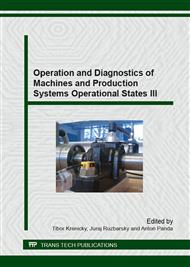[1]
V.P. Astakhov, Surface Integrity – Definition and Importance in Functional Performance, Surface integrity in machining (2010) 1-35.
DOI: 10.1007/978-1-84882-874-2_1
Google Scholar
[2]
M. Hatala, J. Zajac, R. Čep, I. Orlovský, Research of the technological parameters importance for plasma arc thermal cutting, Applied Mechanics and Materials (2012) 110-116.
DOI: 10.4028/www.scientific.net/amm.110-116.3742
Google Scholar
[3]
P.J. Davim, Surface Integrity in Machining, London, (2009).
Google Scholar
[4]
G. Totten, Handbook on residual stress, SEM, Bethel, (2005).
Google Scholar
[5]
V. Trufyakov, P. Mikheev, Y. Kudryavtsev, Fatigue Strength of Welded Structures, Hardwood Academic, London, (1999).
Google Scholar
[6]
L. Radziszewski, Propagation Parameters of ultrasonic Waves in Polymer Composites, Archives of Acoustics 4 (2000) 465-478.
Google Scholar
[7]
P. Beraxa, L. Parilák, M. Ulbrichtová, Increasing Service Life of Tools by CVD Coating, Hutnicke listy 3 (2010) 37-41.
Google Scholar
[8]
B. Kopec et al., Non destructive testing of materials and constructions, Brno, (2008).
Google Scholar
[9]
T. Krenický, Implementation of Virtual Instrumentation for Machinery Monitoring, in: Scientific Papers: Operation and Diagnostics of Machines and Production Systems Operational States: Vol. 4, RAM-Verlag, Lüdenscheid, 2011, pp.5-8.
Google Scholar
[10]
A. Panda, J. Jurko, M. Džupon, I. Pandová, Optimization of heat treatment bearings rings with goal to eliminate deformation of material, Chemické listy 105/16 (2011) 459-461.
Google Scholar
[11]
A. Panda, J. Duplák, J. Jurko, Analytical Expression of T-vc dependence in standard ISO 3685 for cutting ceramic, Key Engineering Materials, 480-481 (2011) 317-322.
DOI: 10.4028/www.scientific.net/kem.480-481.317
Google Scholar
[12]
T. Krenický, Non-contact Study of Surfaces Created Using the AWJ Technology, Manufacturing Technology 15/1 (2015) 61-64.
DOI: 10.21062/ujep/x.2015/a/1213-2489/mt/15/1/61
Google Scholar
[13]
A. Panda, J. Duplák, J. Jurko, Theory and Practice in the process of T-vc dependence creation for selected cutting material, Advanced Materials Research 716 (2013) 261-265.
DOI: 10.4028/www.scientific.net/amr.716.261
Google Scholar
[14]
A. Panda, J. Duplák, K. Vasilko, Comprehensive Identification of Durability for Selected Cutting Tool Applied on the Base of Taylor Dependence, Advanced Materials Research 716 (2013) 254-260.
DOI: 10.4028/www.scientific.net/amr.716.254
Google Scholar


